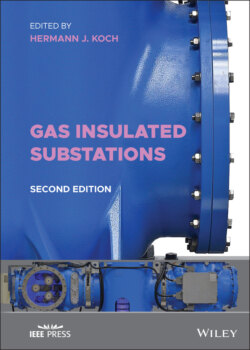Читать книгу Gas Insulated Substations - Группа авторов - Страница 18
1.1.1 Organization
ОглавлениеThe organization of the Substations Committee was developed over the last decades with the focus being on any equipment and systems related to substations. In Table 1.1, the scope of the subcommittees of the substations committee is shown and in Figure 1.1, the organization of the Substations Committee is shown.
IEEE PES Substations Committee has five subcommittees. Three subcommittees are for transmission and distribution (T&D) substations in physical electrical design (D0), physical civil design (E0), and grounding lightning (G0). One subcommittee for power electronic in T&D substations and one for gas‐insulated switchgear (GIS) (K0). For the scope of the subcommittees, see Table 1.1. The administrative substation committee (B0) is represented by the chair, vice‐chair, secretary, past‐chair and holds subcommittees for transactions editor, awards (H0), standards (S0), and meetings (M0).
Table 1.1 Scope of subcommittees of the substations committee
| D0: | Transmission and distribution substation design for a medium‐voltage substation in the range of 1 kV up to and including 52 kV and a high‐voltage substation above 52 kV |
| E0: | Transmission and distribution of substation operations for medium‐voltage substations in the range of 1 kV up to and including 52 kV and high‐voltage substations for above kV |
| G0: | Transmission and distribution of substation grounding and lightning |
| I0: | High‐voltage power electronics stations for DC equipment above 1.5 kV to be installed in a substation or converter station like AC/DC converters, coils, filters, grounding, and software for control and protection |
| K0: | Gas‐insulated substations for AC high‐voltage equipment above 1 kV of switchgear, disconnectors, and ground switches (GIS) and power transmission (GIL) |
The standardization work is split into working groups of the five subcommittees which carry the responsibility for standards and guides. D0 for physical electrical design of substations has seven active working groups: Electrical Clearance D1 (IEEE 1427), Cable System in Substations D2 (IEEE 525), Bus Design D3 (IEEE 605), Seismic requirements to Substation Equipment D4 (IEEE 693), Flexible Bus works in Substations D5 (IEEE 1527), Turnkey Substations D8 (IEEE 1267), and AC/DC Power Supply Systems in Substations D9 (IEEE 1818).
The physical civil design subcommittee E0 is active in six working groups on Community Acceptance of Substations E1 (IEEE 1127), Oil Spill prevention to the substation soil E2 (IEEE 980), Fire Protection E3 (IEEE 979), Animal Deterrents E5 (IEEE 1264), Measuring Earth Resistivity, Ground Impedance, Earth Surface Potentials of a Grounding System E6 (IEEE 81), and Electric Power Substation Physical and Electronic Security E7 (IEEE 1402).
Figure 1.1 Organization of the Substations Committee
The grounding and lightning subcommittee is active in five working groups. G4 is responsible for two standards on Mobile Substation Equipment (IEEE 1268) and Temporary Grounding (IEEE 1246). Lightning Stroke Shielding of Substations of working group G5 (IEEE 998), Grounding Resistivity G6 (IEEE 81), Substation Grounding G7 (IEEE 80), and Qualifying Permanent Connections Used in Substation Grounding G9 (IEEE 837).
The power electronic equipment subcommittee is active in seven working groups. I1 is responsible for two guides, the Functional Specification of Medium Voltage (1–35 kV) Electronic Series Devices for Compensation of Voltage Fluctuations (IEEE 1585) and Electronic Shunt Devices for Dynamic Voltage Compensation (IEEE 1623). For Specifying Thyristor‐Controlled Series Capacitors, working group I2 is responsible. The Functional Specification of Transmission Static Var Compensators (IEEE 1031) and the Field Tests of Static Var Compensators (IEEE 1303) are in the scope of working group I4. The Specification of Transmission Static Synchronous Compensator (STATCOM) Systems (IEEE 1052) is covered by I5; for Control Architecture for High Power Electronics (1 MW and Greater) Used in Electric Power Transmission and Distribution Systems (IEEE 1676), working group I8; for Specification of Transmission Static Synchronous Compensator (STATCOM) Systems (IEEE 1052), working group I9; and for Qualifying Permanent Connections Used in Substation Grounding (IEEE 837), working group I10 are responsible.
The gas insulated switchgear and switchgear assemblies subcommittee covers 13 standards and has 5 more upcoming activities. For High‐Voltage Gas‐Insulated Substations Rated Above 52 kV (IEEE C37.122), K1 is responsible. In K2, GIS Tutorials and Panel Sessions are prepared and presented at IEEE conferences. These tutorials and panels are the basis for this GIS Handbook. K3 is active on the Application of Gas‐Insulated Substations 1–52 kV (IEEE C37.122.2), K4 on SF6 Gas handling (IEEE C37.122.3), K5 on the Gas Insulated Transmission Line (GIL) Application Guide (IEEE C37.122.4), K7 on SF6 to air Bushings for GIS (IEEE C37.017), K8 for the Moisture content in SF6 used in GIS (IEEE C37.122.5), and K9 on Interfaces to GIS (IEEE C37.122.6). Working group K10 is responsible for this GIS Handbook. K11 is active on the GIS User Guide (C37.122.1), K12 on the GIS Specification (IEEE C37.123), and K13 on Medium Voltage GIS for Voltages above 1 kV and up to 52 kV (IEEE C37.20.9).
There are six new standardization activities in the K subcommittee now in work. K14 Condition Assessment of GIS (future IEEE C37.122.9), K15 Recommended Practice of Field Test for GIS (future IEEE C37.122.7), K16 Panel Session on Advanced Sensors for GIS, K17 Panels Session for Physical Security and Resilience, K18 Mobile GIS Applications (future C37.122.8). The main content of this new standards is already covered in the second edition of this GIS Handbook.
The gas‐insulated switchgear and switchgear assemblies (GIS) has a total of 19 working group twelve are listed in Table 1.2.
